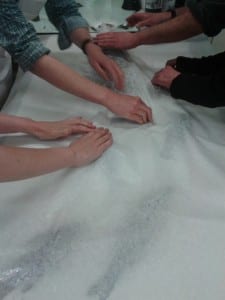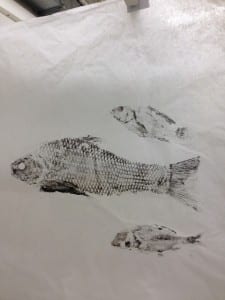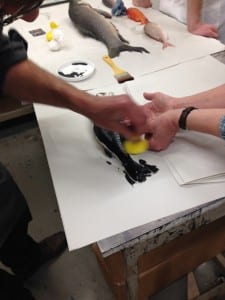Fish printing and reanimating the dead
By Eleanor Morgan, on 14 May 2015
How do you reanimate things that are dead? Since beginning my role as Artist in Residence at the Grant Museum I’ve been worrying at this question. My focus is on the Museum’s collection of glass sponges, but over the past six months these extraordinary animals have pushed me down other paths to explore. Some of these have led to very productive failures.
I’m thinking in particular of my attempts at waterless lithography, which is printing technique that uses silicone (in the form of bathroom sealant) to repel ink. You draw an image on a piece of metal, cover it in bathroom sealant and then once it is dried you wash the metal and the sealant will come off the areas on which you drew your picture. You now have a negative of your picture, which you can ink up and put through a printing press. I thought this was an ideal technique and material with which to explore glass sponges, which are themselves formed of silica. However, the problem came when I looked closer at the bottle of silicone remover that I was using – printed on the back of the label was a drawing of a dead fish. These chemicals are deadly to sea creatures if they enter their ecosystem. It seemed particularly grim for me to pursue a method of making images that could potentially kill its subject.
I’ve recently been exploring another fishy route. I had been told about an old Japanese technique called Gyotaku, which translates as ‘fish rubbing’. Before the invention of photography, fisherman in Japan wanted a way to record the size of their catch. Their solution was to ink up the fish and print it. Working with James Keith, the printmaking technician at the UCL Slade School of Fine Art, I decided to see whether we could make our own fishy prints. We soon realised that we needed some more fish knowledge, so invited artist and fishmonger Sam Curtis to join us. The word/smell gradually spread until we had gathered a crew of five fish printers.
Sam had brought a selection of beautiful and textured fish, which lay together in the printing workshop washed and ready to be inked. We had a selection of four inks to try out – a Chinese calligraphy ink, an acrylic ink, a cuttlefish/gum arabic ink bought from an art shop, and finally a squid ink from a fishmongers. Trying each in turn, it was the squid ink that produced the best results – creating deep black and detailed marks. Rather than being watery, as I had expected, squid ink has a thick jelly-like consistency that seems to lend itself to printing. Importantly, using squid ink would also mean that the fish were still edible after the printing process. The fish and the squid ink seemed to ‘get on’ with each other.

Collaborative rubbing
We inked up each fish and then lay thin Japanese paper on top. Now the rubbing began. Starting with the head of the fish, rub firmly but gently – circular motions with the palm of the hand or fingertips. This was a communal, collaborative fish rub – each of us had our own fish, whose inky outline was visible through the veil of paper. Once the rubbing was done, we removed the paper and the print was revealed. The fish appear almost like fossils, creatures caught in movement at a particular time. There’s a liveliness to the images, which is not just about how they look, it’s also about the process of making them – the direct touch and the gentle rub of five pairs of hands.

Hanging fish prints
Eleanor Morgan is Artist in Residence at the Grant Museum of Zoology, funded by the Leverhulme Trust.
4 Responses to “Fish printing and reanimating the dead”
- 1
-
2
NatSCA Digital Digest | NatSCA wrote on 18 June 2015:

[…] What do you do with a dead fish? Check out this blog for a unique idea: Printing and Reanimating the Dead. […]
-
3
The Top Ten Grant Museum Blogs of 2015 | UCL Museums & Collections Blog wrote on 8 January 2016:

[…] Fish printing and reanimating the dead […]
-
4
Sepia: The Grant Museum | UCL The Pigment Timeline Project wrote on 29 July 2016:

[…] pigment. The latter two functions of this fluid have been combined by our colleague, printmaker Eleanor Morgan who used raw cuttlefish ink in her interpretation of the Japanese art of Gyotaku, producing prints […]
 Close
Close



Hello
Your article is very interesting. Are you planning any art workshops this half term? My 13 year old daughter & myself would be very interested.
Kind Regards
Michelle